| Date/Time | 10:00–13:00 Workshops: |
15:00–18:00 | 19:30–22:00 |
|---|---|---|---|
| Friday, 12. 9. 2014 | Practice in pairs | - | |
| Saturday, 13. 9. 2014 | Practice in pairs | Gala-evening | |
| Sunday, 14. 9. 2014 | Practice in pairs | - |
- Workshops – Experienced teachers will present their methods of work in Tai Chi Chuan and push hands.
- Practice in pairs – Participants will individually agree on how they want to practice in pairs. They will practice in 10-minute rounds. Participants will agree on the type of practice (free push hands vs. form push hands, with steps vs. without steps). The level is always adjusted to the practitioner with less experience.
- Gala-evening – Space for presentations of styles, schools and forms as well as a friendly meeting.
Teachers
Robert Amacker
Biography: 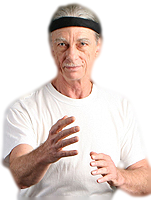 – Born July 14, 1944, in Crockett, Texas
– Born July 14, 1944, in Crockett, Texas
His history in the martial arts begins at age eleven, self-taught in judo to defend against grammar-school bullies. After moving to Hawaii for High School, he began at fifteen to study Kyokushinkai Karate with Bobby Low at the Chinese American Club in Honolulu. College years were spent at University of California and New York University (BA Mathematics) studying Gojuryu Karate, Kyokushinkai’s parent style, with Peter Urban, Aikido with Yoshimitsu Yamada, and eventually Taijiquan with Cheng, Man-ch’ing, and two of his most talented students, William Chen (New York), and Ben Lo (San Francisco). Throughout the seventies he was a student of Chu, Ch’u‑fang, who was one of three people to bring the San Shou form to Taiwan from the Chinese mainland, and was himself a personal student of Yang, Cheng-fu. Since the age of twenty-onehe has devoted himself exclusively to the study of Taijiquan, the only exception being a year of Monkey Style Boxing with Quan, Sai-hung, in San Francisco. He also spent several years in the practice of Zen under the great Yasutani Roshi and his student Mr. Seikido at the Diamond Sangha in Hawaii, and for many years was a professional teacher of hatha yoga. With life-long friend Martin Inn he started the Inner Research Institute of San Francisco and published a translation of the Classics of Taijiquan, later reissued with Ben Lo and Susan Foe in slightly altered form as The Essence of Tai Chi Ch’uan (North Atlantic Press). In 1997 he formed the White Crow School of Taijiquan in Moscow, Russia, and has devoted himself exclusively to this endeavor up to the present time.
Topic:
His workshop will be entirely devoted to what he considers to be the definitive skill of Taijiquan, that is, the ability to make taijis. This is an entirely cooperative skill that compliments the martial aspect of Taijiquan, and is generally referred to as its “Civil” aspect. It is, effectively, a non-zero sum game concealed within a zero sum game. Its complimentary function is the secret to the effectiveness of Taijiquan as a competitive martial art, although its practice itself is completely and demandingly cooperative and non-competitive. It is also the core principle of p’eng chin, and the key to the only method of rooting that is in accordance with Taijiquan’s highest principles. It is explained in elaborate detail in his recently published book, The Theoretical Basis of T’ai Chi Ch’uan, available in February as an Amazon e‑book. The workshopwill be entirely t’ui-shou oriented, and is independent of any style. When the Classics say “In a myriad of techniques, there is only one principle,” it is exactly this principle that will be directly addressed. Its basic practice is equally graspable by expert and beginner alike, and equally enlightening to either.
Links:
- Robert Amacker — T’ai Chi Ch’uan, Music, and Writing
- Taiji pod lupou- The Prague school
- White Crow — The Moscow school
Dan Docherty
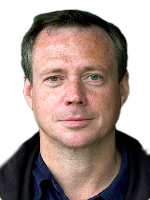 Biography: Dan trained karate from 1871–5. Then he trained in practical Tai Chi Chuan under the late Cheng Tin-hung in Hong Kong from 1975–84. For more details see his web-page.
Biography: Dan trained karate from 1871–5. Then he trained in practical Tai Chi Chuan under the late Cheng Tin-hung in Hong Kong from 1975–84. For more details see his web-page.
Topic: Zou Jin in relation to pushing hands.
Link: Wudang Tai Chi Chuan and it’s practice as a martial art
Roland von Loefen
Biography: 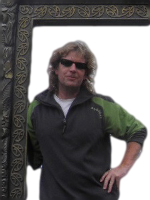 Roland started his Taijiquan — practice 1988 with Helmut Bauer, Barbara Schmid-Neuhaus and Toyo Kobayashi in the tradition of Cheng Man Ching. In 1998, Roland met master Yek Sing Ong and his current teacher Wee Kee Jin. Through long intensive training he eventually became a certified Instructor and Teacher of Wee Kee Jin’s “Taijiquan School of Central Equilibrium”. In 2013 he founded and organized the 1st international push hands meeting in Haßfurt am Main.
Roland started his Taijiquan — practice 1988 with Helmut Bauer, Barbara Schmid-Neuhaus and Toyo Kobayashi in the tradition of Cheng Man Ching. In 1998, Roland met master Yek Sing Ong and his current teacher Wee Kee Jin. Through long intensive training he eventually became a certified Instructor and Teacher of Wee Kee Jin’s “Taijiquan School of Central Equilibrium”. In 2013 he founded and organized the 1st international push hands meeting in Haßfurt am Main.
Topic: We want to work on yielding, pushing with a relaxed force. If you can yield, you have the ability to neutralize the opponents force. Our exercises are fix push hands and semi-free push hands. The advantage of Semi-free Pushing Hands is, that you can learn to listen and sense how your partner behaves. Winning is only secondary as you change roles after 5 minutes.
We are using 3 different stances for this kind of pushing hands.
Links:
Bartosz Samitowski
Biography: Bartosz is a 2nd level international instructor of I Liq Chuan and an 2nd generation lineage inner door disciple of Sam F. S. Chin, the Gatekeeper and Co-founder of the style. He leads his school of I Liq Chuan in Warsaw, Poland and has given seminars in the United Kingdom, Norway and Czech Republic.
Topic: I Liq Chuan is called a “martial art of awareness”, based on Tai Chi principles and Chan (Zen) philosophy. The seminar will offer an introduction to the philosophy, concepts and principles of the system and an overlook of the practice of the style with application in partner work:
- Solo training (“unify the mental and physical”) — 15 basic exercises, body mechanics, Taiji, Yin and Yang, demonstration of the forms of the style and in-depth partner-work with chosen applications to show the principles
- Introduction to partner training (“unify with the opponent”) – the qualities of the point of contact, fullness & emptiness, spinning hands and sticky hands exercises.
Links:
Paul Silfverstråle
Biography: Has studied Asia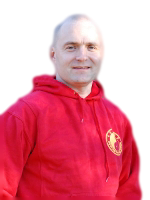 n martial arts for over 25 years, and is a student of Dan Docherty since 1998. He has lived, travelled, practiced and taught extensively in Europe, China and SE Asia, and spent thorough time in Malaysia and Singapore practicing with Wu-style family. Paul is an international tournament winner in forms, pushing hands and San Shou, and many of his students have also been successful on the international competition arena. He works professionally teaching and practicing Tai Chi Chuan, functional training and TCM acupuncture.
n martial arts for over 25 years, and is a student of Dan Docherty since 1998. He has lived, travelled, practiced and taught extensively in Europe, China and SE Asia, and spent thorough time in Malaysia and Singapore practicing with Wu-style family. Paul is an international tournament winner in forms, pushing hands and San Shou, and many of his students have also been successful on the international competition arena. He works professionally teaching and practicing Tai Chi Chuan, functional training and TCM acupuncture.
Topic: Five close quarter strategies in pushing hands:
- Mian – Softness
- Nian – Adherence
- Lian – Continuity and connection
- Sui – To follow/allow
- Bu Diu Ding – Not oppose and not letting go.
Working with these themes in Fixed and Moving Step scenario adding applications.
Student level – Beginner and up.
Links:
- Practical Tai Chi Chuan (home page)
- Wudang Practical Tai Chi Chuan Short Handform (video)
- Leg exercise in Holland (video)
- Basic Entry — Change & Turn (video)
Tomasz (Thomas) Nowakowski
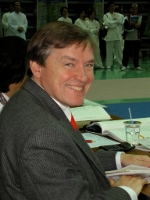 Biography: Tomasz (Thomas) Nowakowski living in London, visual and martial artist. He has studied different martial arts since 1966 and has been teaching T’ai Chi Ch’uan and Qi Gong since 1982. During last 30 years Thomas has taught Tai Chi Chuan and Qi Gong in many countries: Austria, Czech Republic, France, Germany, Italy, Poland, Slovakia, Taiwan and United Kingdom. He has lead workshops at his own school as well as for different companies, cultural and educational institutions. Thomas was a judge at Open National Championship of Taiwan in 2004. He is co-founder The Centre of Taoist Arts Golden Hill (Zlaty Kopec) in Prague, International Push Hands Meeting in Prague and founder Tai Chi Art Centre London. In 1990 he met his current teacher Dr Ming Wong C.Y. and has studied his family style Tai Chi, Tai Ki Kung San Fung and some techniques and theory of Chinese medicine. Thomas is the author of “Shapes of Balance” system (structured development of perception).
Biography: Tomasz (Thomas) Nowakowski living in London, visual and martial artist. He has studied different martial arts since 1966 and has been teaching T’ai Chi Ch’uan and Qi Gong since 1982. During last 30 years Thomas has taught Tai Chi Chuan and Qi Gong in many countries: Austria, Czech Republic, France, Germany, Italy, Poland, Slovakia, Taiwan and United Kingdom. He has lead workshops at his own school as well as for different companies, cultural and educational institutions. Thomas was a judge at Open National Championship of Taiwan in 2004. He is co-founder The Centre of Taoist Arts Golden Hill (Zlaty Kopec) in Prague, International Push Hands Meeting in Prague and founder Tai Chi Art Centre London. In 1990 he met his current teacher Dr Ming Wong C.Y. and has studied his family style Tai Chi, Tai Ki Kung San Fung and some techniques and theory of Chinese medicine. Thomas is the author of “Shapes of Balance” system (structured development of perception).
Topic:
The application of “Shapes of Balance” system (structured development of perception) into practice with partner.
We will be working with “Listening” (ting jin) and “Interpretation” (dong jin), feeling, conscious of:
- balance of structure
- mind intention
- timing
- emission 13 Basic Tai Chi forms of kinetic energy (internal force),
in different level tuishou and applications.
The workshop is open for beginners and advanced.
Links:
- Centre of Taoist Arts Golden Hill (home page)
- Tai Ki Kung
